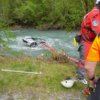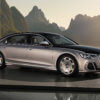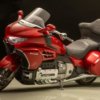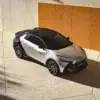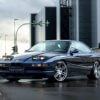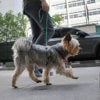Motor editor Vasily Kostin accidentally came across a little-known episode of rally history – the Lada Samara, built in Northern Ireland specifically for asphalt rallies in the late 80s. What’s so interesting about this? After all, eight rally cars were built all over the world, from the Soviet Union and socialist countries to Great Britain, Canada and even Australia – but these cars were approximately the same, complying with the strict rules of the so-called “Group A”. But this car had nothing in common with them, except for its appearance – its entire contents were redone from top to bottom, turning the Samara into a rear-wheel drive car! Read on for more details from those directly involved in the story…
I like to dig through old racing photos sometimes! After all, a considerable part of my life is connected with this – I started writing in the magazine “Motorsport”, and in the company of enthusiastic and competent colleagues I began to follow competitions and become interested in racing technology. I stopped being a motorsports fan a long time ago, but my curiosity and some knowledge remained. I also help my friends run the public “Sputnik Orbit”, dedicated to the history of the “eighth” family – with its founder Zhenya Karpunin, we worked together for some time in the newspaper “Autoreview”.
And so, one day, while studying archival photos from British rallies, I discovered in the photographs a nice white and red V8 with the numbers “IIW 8197”. I have long had a weakness for such exotica: the right-hand drive version of the Lada, and even in a racing version – it would be a shame not to show it to subscribers!
1991 Cavan Stages Rally, Cathal Rogers
Adrian Crawley/ArdeeSnapper.ie
The license plates often accompany the car throughout its life, so it’s not difficult to use them to find other photographs of it. So I came across another collection of photographs of Northern Irish rallies in the early 90s, from which I learned the name of the pilot – it turned out to be rally driver Cathal Rogers from Northern Ireland. Notice how unusually in one of the photographs the car sat on its rear wheels at the exit of a steep hairpin – I also noticed this, but at first I did not attach any importance to it.
 Cathal Rogers at the Donegal International rally in 1991
Cathal Rogers at the Donegal International rally in 1991
Adrian Crawley/ArdeeSnapper.ie
Having the name of the racer, I could continue my search, and soon I discovered an archival photo from the 1991 Donegal International Rally with the caption that amazed me: “Rear wheel drive Lada Samara, Cathal Rogers” – “Rear wheel drive Lada Samara, Cathal Rogers.” So that’s why this car was recorded in the rally protocols as a Group B car! The fact is that after the FIA banned real “Group B” cars, the Irish began to designate in this way equipment prepared according to national technical requirements.
After this, I was simply obliged to find out all the details, and began to write to rally drivers I knew from the UK. It turned out that the rear-wheel drive “eight”, as they say, is “widely known in narrow circles” – it was remembered by many racers who began competing about thirty years ago. But there are no normal publications about it either on the Internet or in specialized magazines of that time, like “Cars and Car Conversions”.
 These nice bumpers, which successfully played off the lines of the “short-winged” Samara, were standardly installed on some cars for the British market. They were installed by local importer Lada Cars UK at their Bridlington base.
These nice bumpers, which successfully played off the lines of the “short-winged” Samara, were standardly installed on some cars for the British market. They were installed by local importer Lada Cars UK at their Bridlington base.
Adrian Crawley/ArdeeSnapper.ie
Veterans told me that Rogers was not the first owner of the V8 – but it was built on the order of another athlete from Ireland, who at that time ran a small Lada dealership. These inputs helped me figure out his name by studying the competition protocols of the late 80s.
The first owner and ideological inspirer was amateur racer Michael Currid from the coastal city of Sligo, in the north-west of Ireland. He was not a rally star, he rarely performed – however, he had quite good results in local races. He drove his first rally in a modest Fiat 128 back in 1976.
 Donegal International Rally 1991, driven by second owner Cathal Rogers
Donegal International Rally 1991, driven by second owner Cathal Rogers
Adrian Crawley/ArdeeSnapper.ie
Fortunately, despite his venerable age, he turned out to be alive and well – he even goes in for cycling with all his might, although he gave up rallying. Michael shared with me details about his Lada.
It turns out that a hybrid of a VAZ V8 and a rear-wheel drive Talbot Sunbeam was built for him! The latter is completely unknown in Russia – and in Europe it’s pretty much forgotten, so we’ll have to give you a little historical education.
Hillman Avenger 1970 model: a rear-wheel drive sedan produced by the European division of Chrysler Corporation, formed the basis of the Talbot Sunbeam hatchback
Chrysler Europe  In this illustration you can see the suspension diagram, which migrated unchanged to the Chrysler Sunbeam. At the front there are MacPherson struts with a composite lower control arm and a lower steering rack, at the rear there is a four-rod axle.
In this illustration you can see the suspension diagram, which migrated unchanged to the Chrysler Sunbeam. At the front there are MacPherson struts with a composite lower control arm and a lower steering rack, at the rear there is a four-rod axle.
Chrysler Europe 
Talbot Sunbeam, also known as Chrysler Sunbeam, is a product of the European division of Chrysler Europe, formed as a result of the American purchase of the British corporation Rootes Group. Since 1970, the company has produced the small rear-wheel drive Hillman Avenger sedan, known under half a dozen different brands: Chrysler, Talbot, Sunbeam, Plymouth, Dodge…
Chrysler Sunbeam is essentially a Hillman Avenger in a more compact body. Pictured is the “charged” version of Ti
Chrysler Germany  Homologation version of the Talbot Sunbeam Lotus with a 16-valve Lotus 2.2 engine. In the production version it produced 152 hp, but for rally cars its power was increased to 250 hp
Homologation version of the Talbot Sunbeam Lotus with a 16-valve Lotus 2.2 engine. In the production version it produced 152 hp, but for rally cars its power was increased to 250 hp
Historics Auctioneers 
Trying to increase their market share, the British decided to release a compact urban hatchback. But for the sake of economy, it was decided to take as a basis a shortened chassis from the Avenger sedan with a continuous axle at the rear. This is how the Chrysler Sunbeam turned out, which went on sale in 1977. Due to the classic layout, the car turned out to be a bit cramped and was not in very high demand. But it was appreciated by rally athletes. And the Sunbeam Lotus version released in 1979 with Lotus’ 16-valve 2.2 engine became the basis for the highly successful Group 2 and 4 rally car.
 In 1981, Talbot won the World Rally Championship in the marque category! Pictured is a genuine historic Group 2 Talbot Sunbeam Lotus (taken today at the Goodwood Festival of Speed).
In 1981, Talbot won the World Rally Championship in the marque category! Pictured is a genuine historic Group 2 Talbot Sunbeam Lotus (taken today at the Goodwood Festival of Speed).
Newspress
However, Michael Currid did not compete in a Lotus, but in a modest car with a 1600 cc engine… He overturned it at one of the races. This is where the story of the rear-wheel drive “eight” begins.
In the eighties, Currid sold Ladas – and one day a client’s Samara was brought to his dealership, beaten in the front end. The insurance company recognized the case as a “total”… Michael decided that this was a good opportunity to return to performing in rallies – he just needed to assemble one car from two.
 The same Talbot Sunbeam Ti that Michael Currid raced on. It was this car that served as the donor for the G8. Photo taken at the Galway Rally in Ireland
The same Talbot Sunbeam Ti that Michael Currid raced on. It was this car that served as the donor for the G8. Photo taken at the Galway Rally in Ireland
Sean Mc Corriston
The word “simply” when applied to such an operation looks a bit outlandish, but such alterations were not unheard of, especially in the first half of the 80s. Front-wheel drive had not yet taken root in motorsport: there were few ready-made solutions for modification, and most racers were accustomed to rear-wheel drive. For example, the well-known company Gartrac converted several dozen third-generation Escorts to rear-wheel drive using parts from the second generation. There was a similar project by Genesis and a lot of custom cars based on the Vauxhall Astra mk1, Vauxhall Corsa mk1, Peugeot 205 and God knows what else.
Joe Nevin from the town of Portstewart on the coast of Northern Ireland worked on the car for Michael. The handy mechanic, who owned a small garage, not only serviced the vehicles of local rally drivers, but also built several cars from scratch. In addition to Lada, these are three Escorts and one Peugeot 205. Joe managed to cross the body of the “Frenchman” with the filling from the rear-wheel drive Opel Ascona 400 group 4 – taking from there a 16-valve Opel-Cosworth engine with a power of about 250 horsepower, a gearbox, brakes, and front suspension together with subframe, rear axle…
 Technical inspection at the car’s debut Galway International Rally in 1988. On the hood and sides of the car there is an advertisement for the Lada dealership, owned by Michael Currid: Newmills Car Sales
Technical inspection at the car’s debut Galway International Rally in 1988. On the hood and sides of the car there is an advertisement for the Lada dealership, owned by Michael Currid: Newmills Car Sales
Sean Mc Corriston
Joe disposed of Samara and the remains of Sunbeam in a similar manner. Hardly anyone took photographs of the process, but Michael was able to remember some details. According to him, instead of the damaged front side members, specially manufactured parts were welded into the VAZ body – while maintaining the standard front suspension support cups. The engine shield was redrawn to move the engine as far back as possible for better weight distribution. And they seriously redesigned the rear part of the body floor to introduce a bridge from Sunbeam on springs and four levers.
 From this photo, everything immediately becomes clear: the rear axle gearbox is peeking out from under the bottom of the Samara!
From this photo, everything immediately becomes clear: the rear axle gearbox is peeking out from under the bottom of the Samara!
Michael Currid Archive
The engine was simply transferred from the Sunbeam. It was a 1600 cc “four” of a conservative design – much less modern than the “Samara” engine: with a cast iron block and head, with intake and exhaust on one side and a camshaft in the block. However, it was located quite high, with very short push rods – which made it possible to “turn” the engine, and large valves and well-shaped gas channels gave decent power: on the serial Chrysler Sunbeam Ti hot hatch, this engine has a pair of horizontal Weber carburetors developed 101 horsepower.
When preparing the engine for the rally, it was equipped with a carefully hung connecting rod and piston group, a modified head from Skip Brown Cars & Components, an original camshaft and carefully tuned Weber 40DCOE carburetors. The characteristics are unknown to us, but we can assume that in the racing version it developed somewhere around 120-130 hp.
 Seamus Glendinning
Seamus Glendinning
The car debuted in 1988 at the Galway International Rally. True, he almost lost it: on the Wednesday before the race, mechanic Joe Nevin went out to check the equipment… and missed the turn, flying into the field. After that, the car was repaired all night, and finally got ready for the start of the rally.
Michael recalled that because of this he did not have time to test the car – and the rear suspension turned out to be too soft, which is why the car tried to turn around on bumps. “Samara” was put in order, and in the summer of 1989 a victory in its class followed in the Donegal International rally. Victory at the Circuit of Ireland rally in 1990 was also close, despite a cracked axle and clutch failure – but a blown head gasket led to a retirement.
Alas, the racing history of the car in the hands of its first owner turned out to be very short. Due to business and family reasons, Michael Currid was forced to give up his racing hobby and sold it to Cathal Rogers. Having taken part in several rallies, he resold the Lada. They say that one of the owners even replaced the original engine with a powerful two-liter unit from the Chrysler 180.
Where is this unusual car now? Alas, it was destroyed in a serious accident at the Northern Ireland UAC Easter Stages rally back in 1995. Fortunately, pilot Alistair Cochrane escaped with only bruises, navigator Ian Kidd suffered a broken arm, but the car was totaled and was written off. The funny thing is that I saw this incident almost twenty years ago, still not knowing anything about this “eight”! Now they would say that the video with the yellow Samara and the cold-blooded photographer “got viral.” But then there was no YouTube yet, and a file with a short recording was simply shared by a few rally fans on their forums. /m

